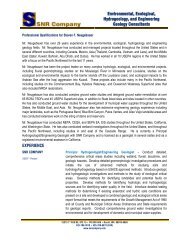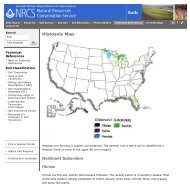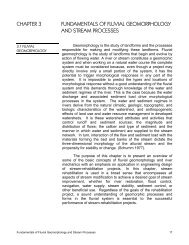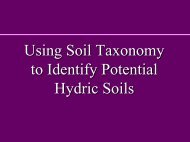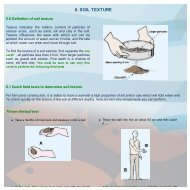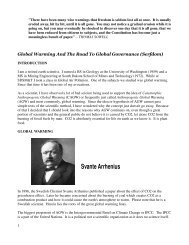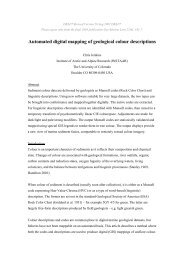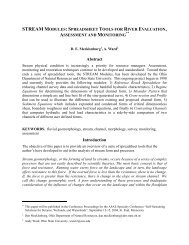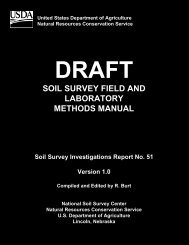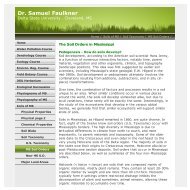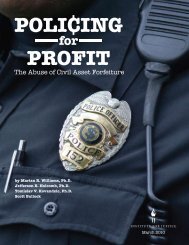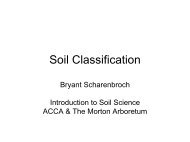SSAGR246_AG151_ Application of the Soil Taxonomy Key to the ...
SSAGR246_AG151_ Application of the Soil Taxonomy Key to the ...
SSAGR246_AG151_ Application of the Soil Taxonomy Key to the ...
Create successful ePaper yourself
Turn your PDF publications into a flip-book with our unique Google optimized e-Paper software.
Extragrade subgroups<br />
Haplosaprists can be classified in<strong>to</strong> three different extragrade subgroups, including Terric, Limnic, and Lithic Haplosaprists (Table 2,<br />
Figure 1). Extragrade subgroup soils reflect specific properties that are o<strong>the</strong>rwise anomalous <strong>to</strong> <strong>the</strong> main concept <strong>of</strong> <strong>the</strong> great group.<br />
These anomalous properties are also not common diagnostic features dominating <strong>the</strong> classification <strong>of</strong> o<strong>the</strong>r known soils and thus do not<br />
reflect an evolutionary transition phase between one soil type and ano<strong>the</strong>r. For this reason, adjectives describing extragrade subgroup<br />
soils are not derived from <strong>the</strong> formative elements used in <strong>the</strong> nomenclature underlying <strong>the</strong> names <strong>of</strong> soil great groups, suborders, and<br />
orders.<br />
Halosaprist subgroup soils in <strong>the</strong> EAA<br />
With respect <strong>to</strong> <strong>the</strong> organic soils in <strong>the</strong> EAA, <strong>the</strong> Torry, Terra Ceia, and Okeechobee soil series have <strong>the</strong> deepest soil pr<strong>of</strong>iles, composed<br />
<strong>of</strong> organic material exceeding 130 cm (51 inches) over limes<strong>to</strong>ne (Table 3). Both <strong>the</strong> Torry and Terra Ceia are classified as Typic<br />
Haplosaprists (Figure 1), which recognizes <strong>the</strong> deep soil pr<strong>of</strong>iles dominated by well decomposed saprist material. The Okeechobee soil<br />
is <strong>the</strong> only intergrade soil subgroup in <strong>the</strong> EAA. Although fairly similar <strong>to</strong> <strong>the</strong> Terra Ceia soil, <strong>the</strong> Okeechobee soil contains a significant<br />
presence <strong>of</strong> less-decomposed hemic materials within <strong>the</strong> subsurface soil pr<strong>of</strong>ile (<strong>Soil</strong> Survey Division, 2001), and is thus classified as a<br />
Hemic Haplosaprist (Figure 1).<br />
The remaining four EAA soil series are classified as extragrade soil subgroups. <strong>Soil</strong> pr<strong>of</strong>iles are less than 130 cm (51 inches) in depth<br />
(Table 3). The Pahokee, Lauderhill, and Dania are classified as Lithic Haplosaprists (Figure 1) due <strong>to</strong> <strong>the</strong> presence <strong>of</strong> a lithic (in this<br />
case, limes<strong>to</strong>ne) contact within 51 inches (130 cm) <strong>of</strong> <strong>the</strong> soil surface (<strong>Soil</strong> Survey Division, 2001; Table 3). Because <strong>the</strong> Okeelanta soil<br />
series is underlain by sandy material (ra<strong>the</strong>r than limes<strong>to</strong>ne bedrock) and/or has a significant accumulation <strong>of</strong> sandy materials within an<br />
o<strong>the</strong>rwise organic soil pr<strong>of</strong>ile (<strong>Soil</strong> Survey Division, 2001; Table 3), it is classified as a Terric Haplosaprist (Figure 1).<br />
<strong>Soil</strong> Family<br />
The soil family category subdivides soils within a given soil subgroup, based on physical and/or chemical characteristics deemed<br />
important <strong>to</strong> soil management, plant growth, and/or engineering uses. <strong>Soil</strong> family names are composed <strong>of</strong> any number <strong>of</strong> appropriate<br />
descriptive terms that identify specific “classes” <strong>of</strong> soil characteristics. In order <strong>of</strong> <strong>the</strong>ir chronological appearance within a family name, <strong>the</strong><br />
soil family classes relevant <strong>to</strong> His<strong>to</strong>sols include particle size, particle mineralogy, soil reaction (pH), soil temperature regime, and soil<br />
depth.<br />
With respect <strong>to</strong> reaction class, all EAA soils are classified as “euic” (whereby soil pH in 0.01 M CaCl 2<br />
> 4.5) due <strong>to</strong> <strong>the</strong> consistently<br />
elevated soil pH levels found throughout <strong>the</strong> region. The “hyper<strong>the</strong>rmic” temperature regime applies <strong>to</strong> all EAA soils [whereby mean<br />
annual soil temperatures are 22°C (72°F) or greater, and average soil temperatures fluctuate more than 6°C (roughly 11°F) between<br />
summer and winter]. The soil depth class applies only <strong>to</strong> <strong>the</strong> Dania soil series, classified at <strong>the</strong> family level as “shallow” [whereby a rootlimiting<br />
layer (limes<strong>to</strong>ne bedrock) is found within 18 <strong>to</strong> 50 cm (roughly 7 <strong>to</strong> 20 inches) <strong>of</strong> <strong>the</strong> soil surface]. The particle size and particle<br />
mineralogy classes apply only <strong>to</strong> <strong>the</strong> single Terric Haplosaprist found in <strong>the</strong> EAA, <strong>the</strong> Okeelanta soil series. The term “sandy or sandyskeletal”<br />
recognizes that <strong>the</strong> particle sizes within <strong>the</strong> Okeelanta mineral layer are sands or loamy sands in texture, with less than 50% (by<br />
weight) very fine sands. The term “silicious” recognizes that <strong>the</strong>se mineral materials are dominated by 90% or more (by weight) silica<br />
materials and o<strong>the</strong>r durable minerals resistant <strong>to</strong> wea<strong>the</strong>ring (<strong>Soil</strong> Survey Staff, 1999; Figure 1).



